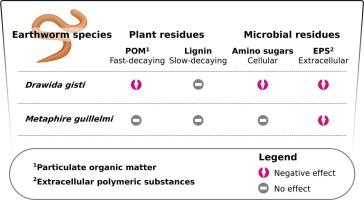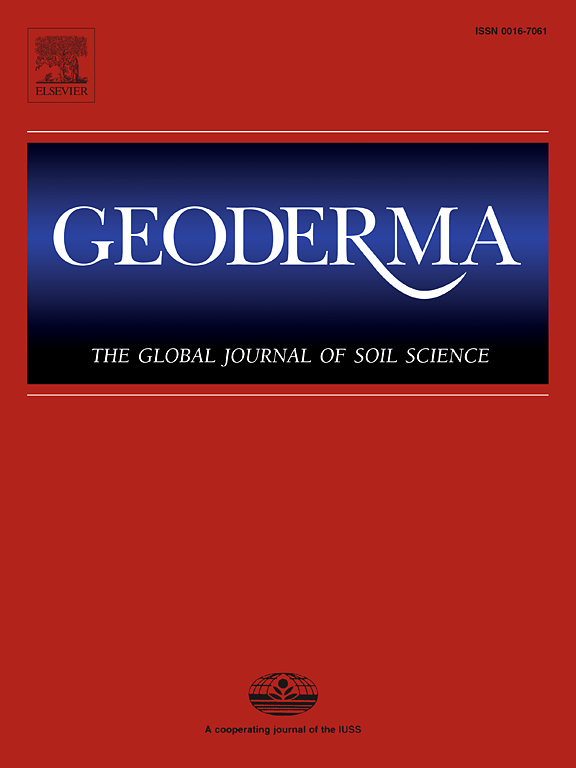Earthworms regulate soil microbial and plant residues through decomposition
IF 5.6
1区 农林科学
Q1 SOIL SCIENCE
引用次数: 0
Abstract
Earthworms are keystone regulators of carbon exchange between terrestrial ecosystems and the atmosphere. However, exactly how earthworms regulate the composition of microbial and plant-derived carbon in soil organic matter remains poorly understood. Here we conducted a microcosm experiment with two species of endogeic earthworms (Drawida gisti and Metaphire guillelmi) to investigate their effects on cellular and extracellular-microbial residues versus fast and slow-decaying plant materials. We found that both species of earthworms reduced microbial residues (amino sugars or the protein content of extracellular polymeric substances (EPS)) and facilitated the decomposition of microbial residues rather than their formation. Neither earthworm species affected slow-decaying plant residues (lignin phenols). However, their effects on the fast-decaying fraction of plant residues (particulate organic matter (POM)) depended on the earthworm species. Principal component analysis (PCA) revealed that earthworms mediated two gradients between microbial and plant residues. The first gradient was between the nitrogenous fraction of microbial residues (e.g., amino sugars and EPS-protein) versus slow-decaying plant lignin, while the second gradient was between the fast-decaying POM versus EPS-polysaccharide. Our results suggest that earthworms play vital roles in mediating plant and microbial residue fractions in soil through their multifaceted mechanisms in regulating the chemical composition of organic carbon, and in understanding biological control of the global soil carbon cycle.

蚯蚓通过分解调节土壤微生物和植物残留物
蚯蚓是陆地生态系统与大气之间碳交换的关键调节者。然而,人们对蚯蚓究竟如何调节土壤有机质中微生物和植物衍生碳的组成仍然知之甚少。在这里,我们用两种内生蚯蚓(Drawida gisti 和 Metaphire guillelmi)进行了微观世界实验,研究它们对细胞和细胞外微生物残留物以及快速和缓慢腐烂植物材料的影响。我们发现,这两种蚯蚓都能减少微生物残留物(氨基糖或细胞外聚合物质(EPS)中的蛋白质含量),并促进微生物残留物的分解而不是形成。两种蚯蚓都不影响慢腐烂植物残留物(木质素酚)。然而,它们对植物残留物中快速腐烂部分(颗粒有机物 (POM))的影响取决于蚯蚓的种类。主成分分析(PCA)显示,蚯蚓介导了微生物残留物和植物残留物之间的两个梯度。第一个梯度是微生物残留物中的含氮部分(如氨基酸糖和 EPS 蛋白)与缓慢腐烂的植物木质素之间的梯度,第二个梯度是快速腐烂的 POM 与 EPS 多糖之间的梯度。我们的研究结果表明,蚯蚓通过其调节有机碳化学成分的多元机制,在调解土壤中植物和微生物残留物组分方面发挥着重要作用,并有助于了解全球土壤碳循环的生物控制。
本文章由计算机程序翻译,如有差异,请以英文原文为准。
求助全文
约1分钟内获得全文
求助全文
来源期刊

Geoderma
农林科学-土壤科学
CiteScore
11.80
自引率
6.60%
发文量
597
审稿时长
58 days
期刊介绍:
Geoderma - the global journal of soil science - welcomes authors, readers and soil research from all parts of the world, encourages worldwide soil studies, and embraces all aspects of soil science and its associated pedagogy. The journal particularly welcomes interdisciplinary work focusing on dynamic soil processes and functions across space and time.
 求助内容:
求助内容: 应助结果提醒方式:
应助结果提醒方式:


